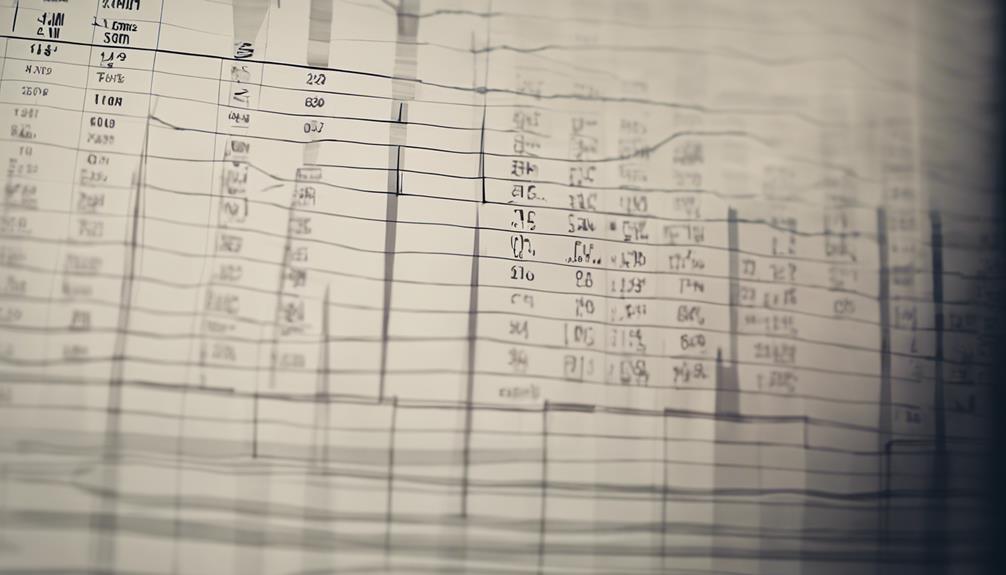Investors who want to improve their stock analysis skills often use different technical strategies. They can look at Moving Averages to see where the trend is heading, or use the Relative Strength Index (RSI) to check how fast a stock is moving.
Fibonacci Retracement Techniques help predict when prices might change direction, and the MACD Indicator is useful for spotting when trends are about to shift. Learning how to recognize Candlestick Patterns can also give important signals.
By using these tools effectively, investors can make smarter decisions in the ever-changing stock market.
Moving Averages Analysis

When investors look at how a stock is doing, they often use moving averages to help them decide when to buy or sell. Moving averages smooth out the ups and downs of a stock's price over a certain period of time. One popular method is exponential smoothing, which gives more importance to recent prices, showing what's happening in the market right now.
Investors use moving averages to find levels where a stock might get support or face resistance. Support levels are prices where a stock tends not to drop below, which could be a good time to buy. Resistance levels are prices where a stock struggles to go above, which might be a good time to sell.
Relative Strength Index (RSI) Strategy
Using the Relative Strength Index (RSI) can help you understand how strong a stock's price movements are. The RSI ranges from 0 to 100 and shows when a stock is overbought (above 70) or oversold (below 30).
Here are some simple tips for using the RSI strategy:
- Overbought Signs: If the RSI is above 70, the stock might be overbought, which could mean a price reversal.
- Oversold Signs: When the RSI is below 30, it suggests the stock is oversold, possibly indicating a price increase.
- Divergence Clues: If the RSI and stock price move in different directions, it could signal a potential reversal.
- Confirming Signals: Always double-check RSI signals with other indicators or price movements before making decisions.
- Setting Targets: Have realistic profit goals and stop-loss levels based on RSI readings to manage risks effectively.
Fibonacci Retracement Techniques

Now that you know about the Relative Strength Index (RSI) strategy, let's talk about Fibonacci Retracement Techniques to help you analyze stocks better.
Fibonacci retracement is a tool used in technical analysis to find levels where an asset's price could bounce back before continuing its previous trend. By drawing lines at key Fibonacci levels like 23.6%, 38.2%, 50%, 61.8%, and 100%, you can predict where the price might find support or face resistance.
Here's a simple breakdown of Fibonacci levels and their significance:
- 23.6%: Shows a small bounce back
- 38.2%: Indicates a moderate bounce back
- 50%: Halfway point, suggests a possible trend change
- 61.8%: Signifies a strong bounce back
- 100%: Full bounce back, indicating a trend reversal
Understanding these levels can help you identify potential support areas and spot trend reversals, which can be useful for making smart investment choices.
MACD Indicator Application
When we look at the MACD indicator in stock analysis, we can learn a lot about market trends and possible trading opportunities. The MACD (Moving Average Convergence Divergence) is a tool that helps investors make smart choices.
Here are some important things to think about when using the MACD indicator:
- Signal Crossover: When the MACD signal line crosses above or below the MACD line, it could be a sign to buy or sell.
- Histogram Interpretation: The height of the bars on the histogram shows how far apart the MACD line and signal line are, giving us an idea of how strong the price momentum is.
- Divergence Analysis: If the MACD indicator and the stock price move in different directions, it might mean a trend reversal is coming.
- Trend Confirmation: By using the MACD to confirm a trend's strength, investors can avoid falling for false signals.
- Historical Analysis: Looking at past MACD movements can tell us how the stock price behaved in similar situations.
Candlestick Pattern Recognition

When looking at how stocks are doing using the MACD indicator, it's also helpful to pay attention to Candlestick Pattern Recognition. Candlestick patterns give us clues about how people feel about the market and where prices might go next.
Two important patterns to watch for are the bullish engulfing pattern and the doji formation.
- Bullish Engulfing: This pattern happens when a small candle that shows a drop in prices is followed by a bigger candle that completely covers the range of the previous one. This suggests a possible shift from a downward to an upward trend.
- Doji Formation: A doji forms when the opening and closing prices are almost the same. This shows uncertainty in the market and could mean a change in the trend, depending on the situation.